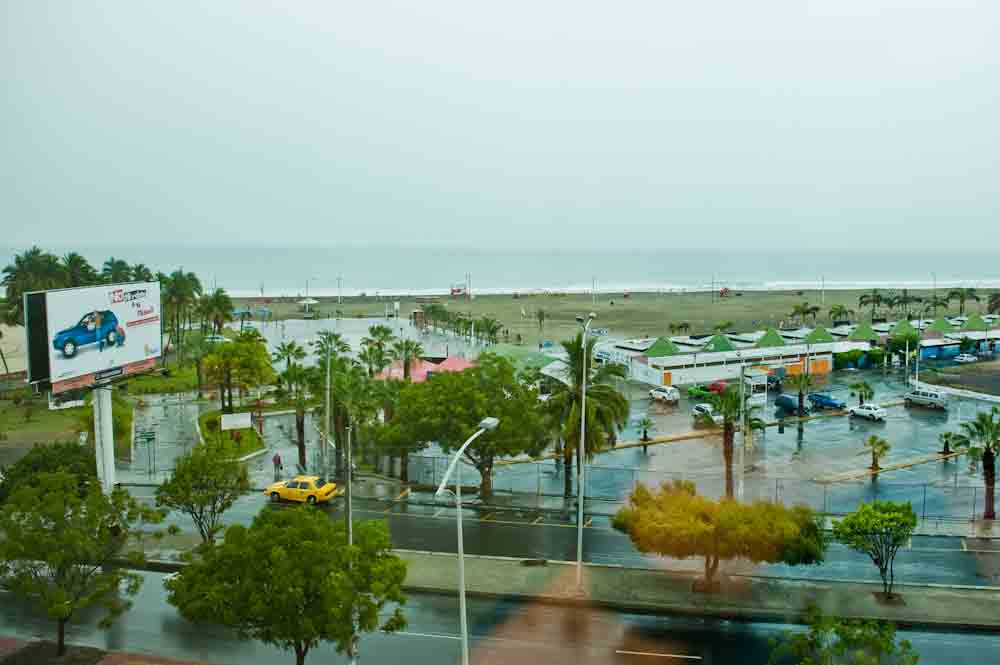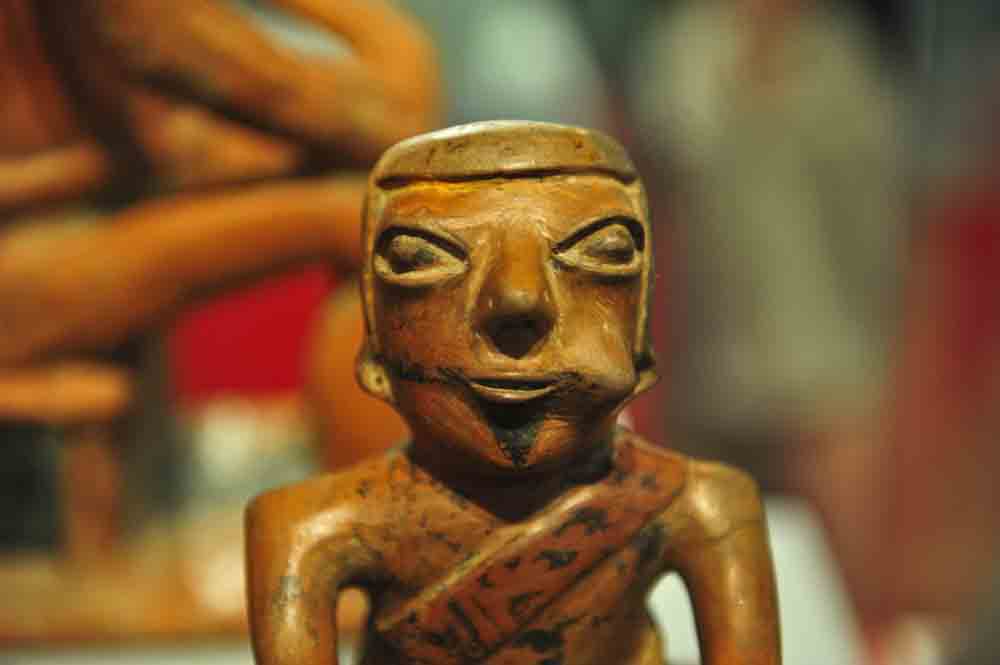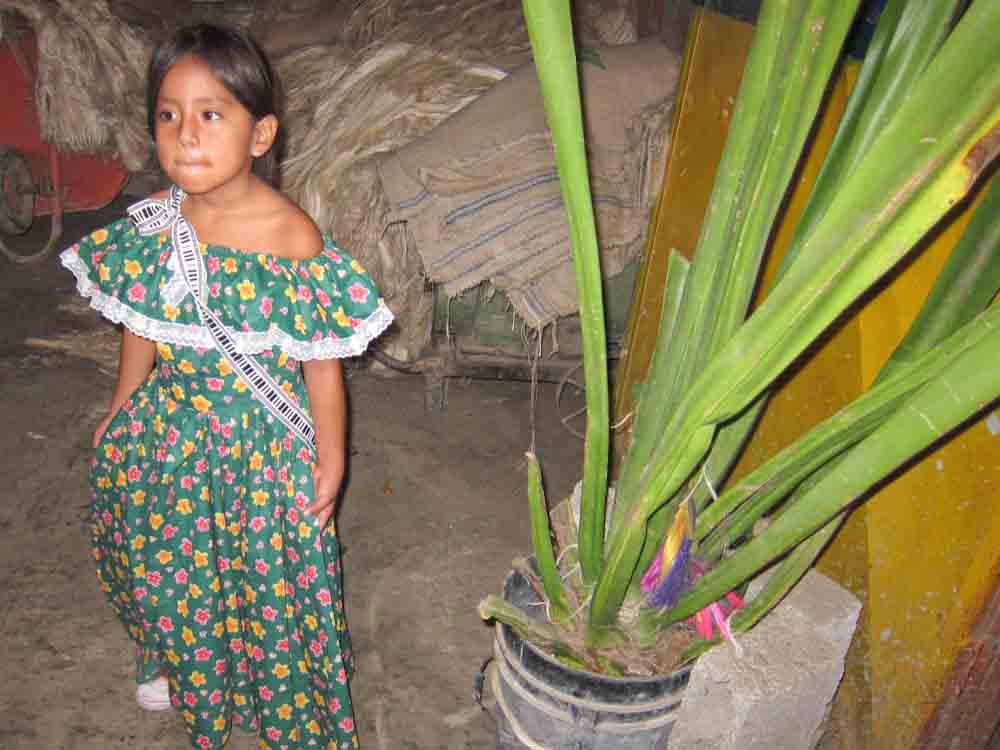
We arrived in Manta Ecuador today…the home of the original Panama hat! Under gray threatening clouds with intermittent sprinkles I boarded a very modern and comfortable bus at the dock for a four part city tour. Our tour guide was a woman who spoke reasonable English and was genuinely enthusiastic about her city. The first stop was a museum that was fairly near the port and enabled us to take a drive along the shore and get a feel for the city. It was fairly modern with decent beaches, some nice and modern buildings and generally nice retail stores.

The museum was a multi-story building that was modern and the exhibits were professionally done although most of the text was in Spanish. It consisted of historical artifacts, many from prehistoric times. Turns out that people in this area are some of the first inhabitants of the Americas and they were fairly advanced with their pottery and metal working. Many of the pieces were related to the work of the medicine men. There was also a section that had modern art although I didn’t really see the relevance. A couple samples are in the picture gallery. They also had a grave site that included a skeleton to show how they would have buried their dead and also how they found a couple buried together with their arms around each other.

After walking around a bit and buying some local pottery items to decorate our suite we drove to a hillside area and parked in an asphalt town square. There were stands setup around the square selling local wares including Panama hats. While I wanted to get a hat I figured that the next shopping area would have more choices and held off despite the hat people chasing after me. We were taken into what looked like an underground parking garage on the outside of the building but turned out to be a manufacturing plant for sisal, the twine-like substance made from a local plant.

One guy takes the 3-5 foot stalks from the sisal plant which appears to be like a cactus and whacks them onto a device that has a number of sharp nails sticking up. That breaks up the fibers from the stalk and, eventually, after a lot of whacking, he ends up with long fibers that are passed onto a group of ladies who sit at an ancient spinning machine that takes the fibers and turns our sisal yarn. It is a crazy contraption but pretty ingenious. It also must be pretty darn sturdy since it seems to have lasted 100 years. Those ladies were anxious to get tips if you took their picture. $1 seemed to get the job done.
Oh, by the way, the whole point of this sisal manufacturing process was to make 100% certified organic, bio-degradable burlap bags (they are actually “sisal” bags)! They are very proud of the fact that they ship their coffee from Ecuador in these bags. It makes the coffee taste better, breathes better and, once again, is all natural and non-polluting. Seems we just need to go back in time to avoid some of the problems we have with the environment.
OK, back to the story. We have sisal yarn which is quite sturdy and softer than you’d think. It is used in many applications but, in this case, it is passed onto spools and put in inventory for the ancient loom that was around the corner. As you can see from the pictures, he has hundreds of spools feeding a completely manual loom device that has many moving parts. It also has a device that adds natural red die to the middle fibers to put the red stripes on the finished bag. He operates the loom with great precision, having to feed a new fiber cross-ways from time to time. While it seems that it is a very slow process he can actually crank out a huge number of bags a day. It really makes you wonder if all the automation we have done really adds much when you consider the labor involved in the computers, machinery and the cost of all that technology. The bags that he produced were beautiful, strong and is the most efficient and “keep the coffee tasting fresh” way to transport items like coffee. Very interesting. Throughout there were children assisting in various tasks. They also were dressed in native garb and were more than happy to pose for pictures in this underground manufacturing plant.

Next we drove to a marketplace that was located on a hilly area of town. There were a number of shops, especially ones that specialized in Panama hats. Turns out that this type of hat was really invented and manufactured in Ecuador but Teddy Roosevelt wore one when he toured the Panama Canal back in the early 1900’s. Everyone took a liking to the hat they saw in the pictures and, because he happened to be in Panama the die was cast. Ecuador would lose out on all that PR. But they still retain the status of being THE place to get a Panama hat. The best ones are hand-made and take considerable labor. There were some ladies actually making the hats on the streets. Many of the Regent guests bought hats including me. I got a cheap one for me (not easy with my big head!), a very nice one for Margaret and the place threw in a nicer one for me at a great price. So, we are now loaded up with our quota of Panama hats!

The last stop of the bus was, get ready for this, an organic button manufacturing company. Really. There is a type of nut called the tagua that is about the size of a small lime and is brownish in color. They are quite hard and look like ivory inside. For all practical purposes, it is treated as an ivory substitute. The company we were taken to specializes in making stuff out of the tagua nut including buttons and assorted knick knacks like small penguins, other assorted birds and animals of all types. Pretty amazing. We were taken through the process of how they make buttons from the raw nut and, sure enough, they can crank out a lot of buttons using pretty basic manufacturing processes like a table saw, lathe and a special purpose drilling machine that drills the four holes. They make a wide variety of buttons in all shapes, sizes and colors and sell them both loose and in small packages. Now you know more than most people about organic buttons. See the Picture Gallery for more examples.

We ended the day in the Connoisseurs Club (a fancy name for the smoking and cognac lounge) with Douglas, the Concierge with whom Margaret has made friends. Good times.

Manta, Ecuador Picture Gallery: http://travelwithdm.smugmug.com/Travel/South-America/Ecuador-Jan-20-2010/25153200_g6Wkgz#!i=2062594458&k=wWQdv5K


.jpg)